In our first class of the week, we were placed in Professor Jack’s group and we explored how games can be conceived and performed in contemporary art.
After reading the book “Critical Games: Radical Game Design“, I found that the author’s main focus is on some critical game ideas, through her creative practice, through a series of games (board games, language games, artists’ Location games, and important computer games, etc.) For many gamers, games exist for entertainment, to pass the time, and to have fun. They’re a distracting activity where players can freely engage in fantasy narratives, amazing feats, and rewarding quests. But she has questions about the power of the game, but what if certain games become more powerful? What if certain games, and the more general concept of “game”, not only provided channels for entertainment, but also served as a means of creative expression, a tool for conceptual thinking, or a tool to help examine or solve social problems? Therefore, many cases and practical contents in this book break the conventional way to play games and open up the possibility of games. It is the way, mode, and flow of the game. Computer games are often seen as a new medium, not necessarily in line with other forms of gaming as such.
The approach to critical play is a cyclical framework, set goals – set goals – develop a prototype – play test – revise – repeat. Traditional models contain specific steps to implement a particular design by iterating it until the core elements and concepts have adequately matched game elements and mechanics. Like art, creating games and games requires fundamentally making rules. Even simple role-playing activities or playhouses, two seemingly infinite open-ended scenarios, include implicit or established behaviors, possible actions, environments, and safe play areas with clear rules. Because of the systemic nature of products and processes, game makers use specific repeatable processes or methods.
▪️In our practice process, we also refer to the book “Critical Games: Radical Game Design”, which mentions several concepts of games, games are a system, games are artificial, games have players, games have conflicts, and games have the law.
The game contains a quantifiable outcome/goal, and several designers noted the importance of rules in building the game, which adds varying degrees of storytelling, conflict, and competition systems. One can choose not to follow such a strict definition. Games can be thought of more effectively as situations and procedures with guidelines.

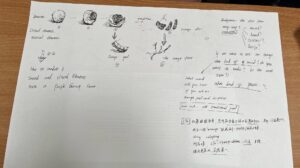
🍊When we received two bags of tangerines and 25 kinds of tangerines that Jake gave us different ways to eat and play, we were amused and puzzled, a lot of behaviors we didn’t understand. We try to analyze the oranges by combining them with games, the process of stripping the oranges, and asking “if we want to eat an orange what kind of sound do you want to make? How to combine 6 sound and visual elements into a purple group score.
🔺Then our group extended based on oranges and eating, through 25 ways of eating an orange🔺 Because each way of eating an orange has a different sound, we use hearing and other senses to connect. Although eating an orange appears to be just the act of eating, it is a coordinated effort of five sensory systems. With the current bad eating habits of people, we are constantly consuming this sensory system of eating and digesting, and the ability of human beings to absorb is gradually getting worse. 💡Therefore, we want to mobilize one sense to replace other senses. So we need to change the way of “eating” from purely eating and chewing to filling in codes to our bodies. Human beings are constantly deteriorating and deteriorating, so the way many sensory systems are used has also changed, and the ingested content has gradually changed from physical objects to real objects. The virtual voice is gradually converted from voice to code and data, and then a complete human structure is built through data and code because replacing other senses with mechanization is a response to future crises. In the future, data will gradually meet human needs. After the idea structure is completed, our group collects and organizes the oranges and sounds respective, from eating to listening, completely changing the way of “eating oranges”.
Interactive interface experience Record screen videos⬇️
🔗https://www.instagram.com/p/CjqGCrXLasj/?igshid=YmMyMTA2M2Y=
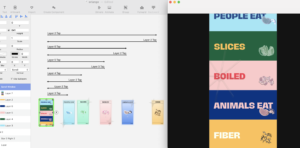
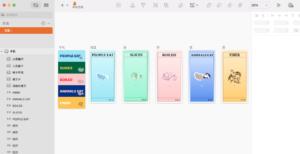
(⬆️Our team has a clear division, I am mainly responsible for the interactive page and the final user experience through sketch and principle.)
After the idea structure is completed, our group collects and organizes the oranges and sounds respective, from eating to listening, completely changing the way of “eating oranges”. We have a clear division of labor, and we have done a corresponding survey on how to eat oranges and found a lot of different sounds such as: squeezing oranges, eating oranges, squeezing oranges, and so on. In the future we will listen to these sounds and then ingest them (sounds can be arranged in various combinations), really like Ghost in the Shell, “Mechanical flesh soul soaring”, sounds became codes(data). Games are creative, collective, and social responses to the practices and beliefs that dominate any culture, and games also imprint our culture on the motivations and values of designers. Imagine eating oranges not only by eating the pulp, trying eating oranges not just peeling and eating them, trying to “eat” oranges without using your mouth but by “listening” with your ears, and imagine how artificial humans will satisfy their “hunger” in the future, and choose the oranges you want to try.
video⬇️
🔗https://youtu.be/VlgDC3Ju7kM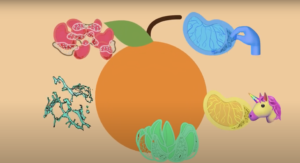
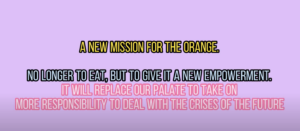
Sequence, to satisfy the appetite with hearing. After the end, we submitted an application for the shared license, and we chose the license CC-BY-NC-SA 4.0. This practice gives oranges a new mission, No longer to eat, but to give it new empowerment, it will replace our palate to take on more responsibility to deal with the crises of the future. Humanity will have a new way of thinking in the future. What is the new upgrade of the five senses? What will the failure of our organs bring us? Choose the orange you want to eat, the orange will tell you its voice.


I remember your group’s classroom sharing, which I found interesting at the time, that your theme was oranges and then created the interactive interface and some sound parts. I could feel the effort and seriousness of your work and I could see the collaboration of your team, it was really great work. Reading your text, I understood your concept, you reflected on oranges and the human sensory digestive system, using sound translated into code, which is really cool, very cutting edge art form.
This blog post your work in this week and includes some reflection on the work you undertook in your group to design a new game. You note that you evaluated the decisions your group took to arrive at your final idea. I remember that your work posts was really interesting and is about an interactive game on website. Your blog also provide an overview for your major challenges, decisions and insights.
Zhiqian Zhang, this a great blog post that interweaves the textual materials you explored with the outcome of your group’s activity. It was great to see how Flanagan’s text helped inform your understanding and working process in creating the orange interface. It was also really encouraging to see how you brought other themes such as posthumanism and futurology into conversation with Play to narrativise a scenario in which your ideas could take flight, in particular your envisioning of failing organs and how interacting with an organge could change over time. The Orange interface itself is rendered in a really interesting way that demonstrates the depth of thinking and work that went into manifesting your idea.
The blog post is an improvement on your first one, it makes better use of documentation from the sprint in relation to your reflections on your experience. It was also great to see you citing sources you engaged with, just try to also include full academic references in future posts, this way the reader can research the sources and examples you use in your work.- Keep up the good work!
I really love our basho and I learn from your note-taking. It is a circle and colorful notes, it is clear and conprehensive.